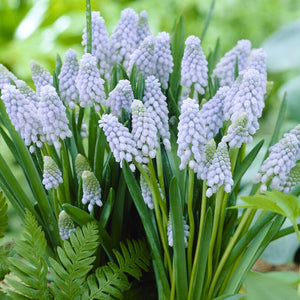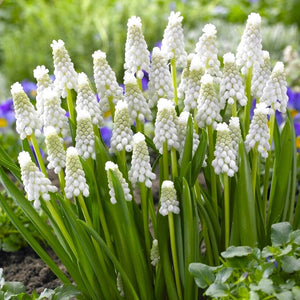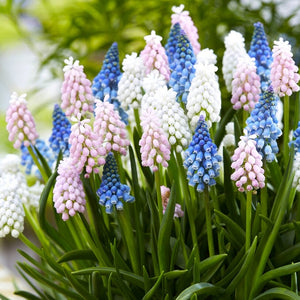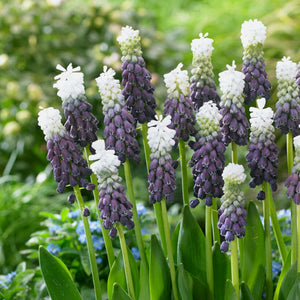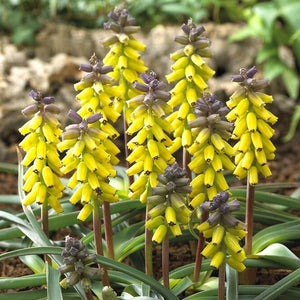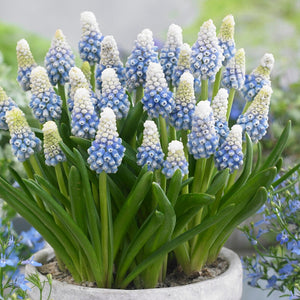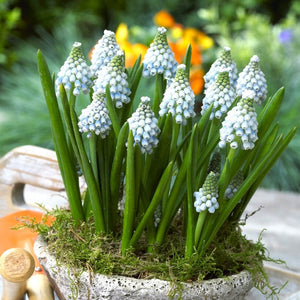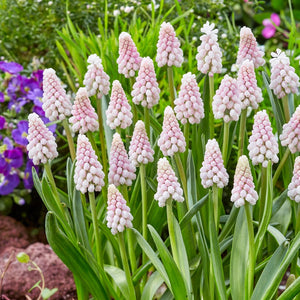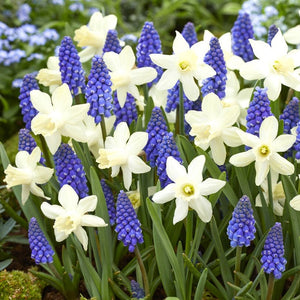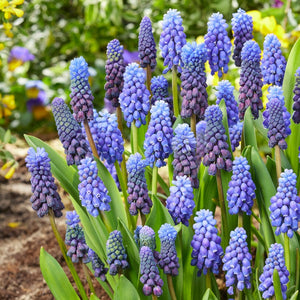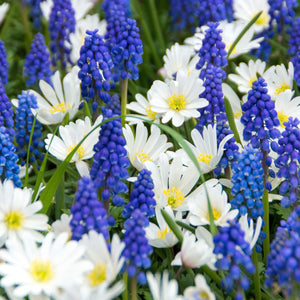- Home
- Planting Guides
- Grape Hyacinth (Muscari) Planting & Growing Guide
Grape Hyacinth (Muscari) Planting & Growing Guide
Between their extraordinary fragrance, fabulous colors, and breathtaking forms, Grape Hyacinths are true winners. Also known as Muscari, these beauties give the illusion of plump bunches of grapes adorning the springtime garden. So, are you ready to add these low-maintenance butterfly magnets to your landscape? Find out just how easy they are to plant and grow with this guide!
Success Snapshot
PLANTING
DEPTH
3"

WATER
QUANTITY
Moderate
SUNLIGHT
QUANTITY
Full to Partial Sun
PLANTING
PROXIMITY
3" Apart
BLOOM
SEASON
Spring
HARDINESS
ZONES
Zones 4-8
Shop Related Products
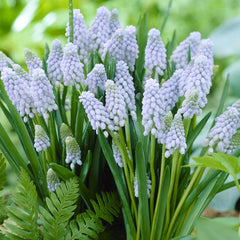
Muscari - Grape Hyacinth Valerie Finnis
$4.95
Contains: 10 Muscari bulbs
Botanical Name: Muscari armeniacum 'Valerie Finnis'
Exposure: Full Sun to Partial Sun; Bright Direct Indoors
Hardiness: Zones 4-8
Muscari & Tulip - Baby Shower Blend
$24.95
Contains: 10 Tulip and 10 Grape Hyacinth bulbs
Botanical Name: Muscari and Tulipa
Exposure: Full Sun to Partial Sun; Bright Direct Indoors
Hardiness: Zones 4-8
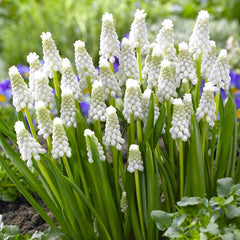
Muscari - Grape Hyacinth Siberian Tiger
$2.95
Contains: 10 Muscari bulbs
Botanical Name: Muscari armeniacum 'Siberian Tiger'
Exposure: Full Sun to Partial Sun; Bright Direct Indoors
Hardiness: Zones 4-8
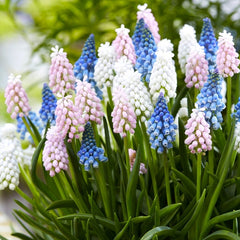
Muscari - Grape Hyacinth Skylight Mix
$17.95
Contains: 30 Muscari bulbs mix
Botanical Name: Muscari
Exposure: Full Sun to Partial Sun; Bright Direct Indoors
Hardiness: Zones 4-8
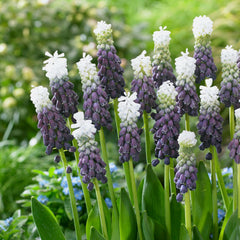
Muscari - Grape Hyacinth Grape Ice
$4.95
Contains: 10 Muscari bulbs
Botanical Name: Muscari armeniacum 'Mountain Lady'
Exposure: Full Sun to Partial Sun; Bright Direct Indoors
Hardiness: Zones 4-8
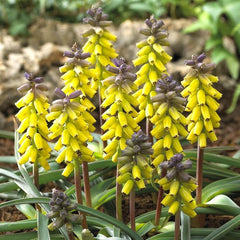
Muscari - Grape Hyacinth Golden Fragrance
$4.95
Contains: 5 bulbs
Botanical Name: Muscari macrocarpum 'Golden Fragrance'
Exposure: Full Sun to Partial Sun; Bright Direct Indoors
Hardiness: Zones 5-8
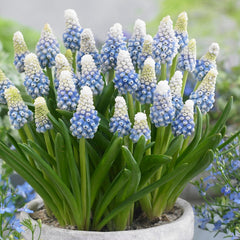
Muscari - Grape Hyacinth Mt. Lady
$4.95
Contains: 10 Muscari bulbs
Botanical Name: Muscari armeniacum 'Mountain Lady'
Exposure: Full Sun to Partial Sun; Bright Direct Indoors
Hardiness: Zones 4-8
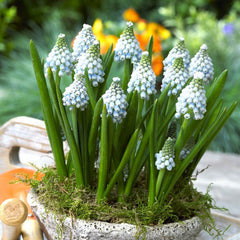
Muscari - Grape Hyacinth Ocean Magic
$3.95
Contains: 10 Muscari bulbs
Botanical Name: Muscari aucheri 'Ocean Magic'
Exposure: Full Sun to Partial Sun; Bright Direct Indoors
Hardiness: Zones 4-8
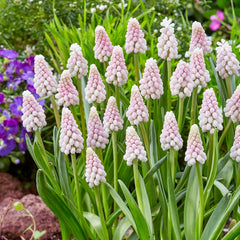
Muscari - Grape Hyacinth Pink Surprise
$9.95
Contains: 10 Muscari bulbs
Botanical Name: Muscari armeniacum 'Pink Surprise®'
Exposure: Full Sun to Partial Sun; Bright Direct Indoors
Hardiness: Zones 4-8
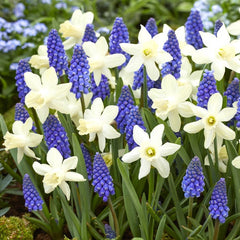
Muscari & Narcissus - Serenity Blend
$28.95
Contains: 30 muscari bulbs and 10 daffodil bulbs, clearly marked
Botanical Name: Muscari and Narcissus
Exposure: Partial Sun; Bright Direct Indoors
Hardiness: N/A

Muscari - Grape Hyacinth Blue
$4.95
Contains: 30 Muscari bulbs
Botanical Name: Muscari armeniacum
Exposure: Full Sun to Partial Sun; Bright Direct Indoors
Hardiness: Zones 4-8
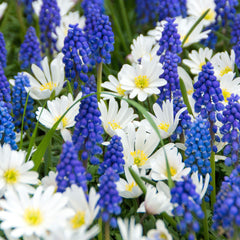
Anemone & Muscari - Fun & Flirty Blend
$19.95
Contains: 1 pack of 20 Anemone Blanda bulbs and 1 pack of 30 Muscari Blue bulbs
Botanical Name: Anemone and Muscari
Exposure: Full Sun to Partial Sun
Hardiness: Zones 4-8
Where to Plant
Grape Hyacinths are straightforward plants to grow in both containers and outdoor gardens, fancying little more than well-drained soil and a spot with good light. If you notice puddles of water 5–6 hours after a hard rain, scout out another site or amend the soil with organic material to raise the level 2–3 inches. While these beauties aren't particularly fussy about soil, they will not survive in soggy conditions or standing water.
When to Plant
Muscari bulbs should be planted sometime between mid to late fall after the first frost but before the ground freezes. After a few years, most varieties will produce roots and send up foliage in the fall that persists through winter until the flowers arrive in early spring.
How to Plant
- For outdoor landscape planting, find a spot where the soil drains well, and your Muscari plants will receive plenty of sunlight. Full or three-quarter-day sun exposure will yield the best blooms. Dig holes and plant the bulbs 3 to 4" deep and 3" apart, with the small points on the sides facing up.
- For container planting, start with good quality, well-drained potting soil and tall or shallow containers with adequate drainage holes. Dig holes and plant the bulbs 3 to 4" deep and 3" apart, with the small points on the sides facing up.
- Water thoroughly, soaking the soil to settle it around the bulbs.
How to Grow
- Water as needed during active growth periods, with about 1" of moisture per week as a fair estimate.
- Leave the foliage in place after blooming has finished for the season. The leaves will gather sunlight to create food through photosynthesis, strengthening the bulb for the future.
- Remove the dry foliage when the leaves turn yellow and die back late in the spring.
- Allow the bulbs to rest for a few months before beginning the next growing cycle.
Grape Hyacinth Tips & Tricks
- Amend the soil with finely ground bark, decomposed manure, or compost to improve drainage and encourage a healthy start.
- Consider mixing other petite plants, such as Pansies or miniature Daffodils, with your Grape Hyacinths, or tuck them around the ankles of taller plants.
- Feel free to snip a few flowers for tiny, perfect bouquets, as doing so will not hurt your plants.
- Dig up the bulbs and separate them if your Grape Hyacinths begin to get crowded, as this will disrupt flowering. These plants are known to self-seed and spread over time, which is fantastic but needs to be maintained.
- Expect your Muscari plants to perform beautifully for many years on end!

